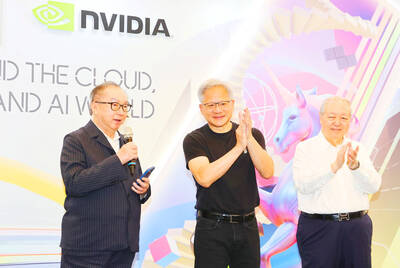Australia yesterday kept interest rates at a record low, as it has for the past two years, while a currency sliding toward US$0.70 offers the prospect of additional stimulus for the economy.
As expected, Reserve Bank of Australia (RBA) Governor Philip Lowe left the cash rate at 1.5 percent, a stance he expects would eventually tighten the labor market and spur enough wage growth to speed up inflation.
While the Australian dollar’s more than 10 percent drop since February might help quicken the process, there is a risk that rising mortgage rates and falling property prices could encourage households to put away their wallets.
“One continuing source of uncertainty is the outlook for household consumption,” Lowe said in a statement after the decision. “Household income has been growing slowly and debt levels are high.”
On the exchange rate, Lowe said: “It has depreciated against the US dollar along with most other currencies.”
The RBA has said its next rate move is more likely to be up than down; Lowe, since taking the helm in September 2016, has been reluctant to cut further, given the diminishing returns from easier policy.
However, the RBA’s stimulus was eroded somewhat, when Westpac Banking Corp last week said it was hiking its key mortgage rate by 14 basis points, more than half a typical RBA increase, to compensate for higher offshore funding costs.
That prompted traders to push out their bets for the bank’s first rate hike since 2010 and drive down the currency.
Many analysts now see the Australian dollar dropping into the 60s, potentially boosting the competitiveness of exporters and import-competing industries, and allowing them to take on more staff.
The Aussie dollar would probably need to fall into the 60s for a sustained period — potentially almost a year — to change the RBA’s calculations.
“The RBA retained its outlook for growth and inflation, shrugging off heightened trade tensions between the US and China, and a sharp slide in the Aussie dollar,” Bloomberg economist Tamara Mast Henderson said.
“Importantly, the central bank still expects the pick-up in wage growth to be a gradual process. We think the RBA will remain on hold through most, if not all, of next year,” Henderson added.
The central bank does not see unemployment falling to the 5 percent level generally associated with faster wage growth until December 2020. The jobless rate is currently 5.3 percent.
Australia is also on track for a change in government in the first half of next year to a less business-friendly administration. The Labor Party might dilute the current government’s income tax reductions that — in an environment of stagnant wages — are one of the few options available to boost household incomes.

Leading Taiwanese bicycle brands Giant Manufacturing Co (巨大機械) and Merida Industry Co (美利達工業) on Sunday said that they have adopted measures to mitigate the impact of the tariff policies of US President Donald Trump’s administration. The US announced at the beginning of this month that it would impose a 20 percent tariff on imported goods made in Taiwan, effective on Thursday last week. The tariff would be added to other pre-existing most-favored-nation duties and industry-specific trade remedy levy, which would bring the overall tariff on Taiwan-made bicycles to between 25.5 percent and 31 percent. However, Giant did not seem too perturbed by the

AI SERVER DEMAND: ‘Overall industry demand continues to outpace supply and we are expanding capacity to meet it,’ the company’s chief executive officer said Hon Hai Precision Industry Co (鴻海精密) yesterday reported that net profit last quarter rose 27 percent from the same quarter last year on the back of demand for cloud services and high-performance computing products. Net profit surged to NT$44.36 billion (US$1.48 billion) from NT$35.04 billion a year earlier. On a quarterly basis, net profit grew 5 percent from NT$42.1 billion. Earnings per share expanded to NT$3.19 from NT$2.53 a year earlier and NT$3.03 in the first quarter. However, a sharp appreciation of the New Taiwan dollar since early May has weighed on the company’s performance, Hon Hai chief financial officer David Huang (黃德才)

NVIDIA FACTOR: Shipments of AI servers powered by GB300 chips would undergo pilot runs this quarter, with small shipments possibly starting next quarter, it said Quanta Computer Inc (廣達), which supplies artificial intelligence (AI) servers powered by Nvidia Corp chips, yesterday said that AI servers are on track to account for 70 percent of its total server revenue this year, thanks to improved yield rates and a better learning curve for Nvidia’s GB300 chip-based servers. AI servers accounted for more than 60 percent of its total server revenue in the first half of this year, Quanta chief financial officer Elton Yang (楊俊烈) told an online conference. The company’s latest production learning curve of the AI servers powered by Nvidia’s GB200 chips has improved after overcoming key component

UNPRECEDENTED DEAL: The arrangement which also includes AMD risks invalidating the national security rationale for US export controls, an expert said Nvidia Corp and Advanced Micro Devices Inc (AMD) have agreed to pay 15 percent of their revenue from Chinese artificial intelligence (AI) chip sales to the US government in a deal to secure export licenses, an unusual arrangement that might unnerve both US companies and Beijing. Nvidia plans to share 15 percent of the revenue from sales of its H20 AI accelerator in China, a person familiar with the matter said. AMD is to deliver the same share from MI308 revenue, the person added, asking for anonymity to discuss internal deliberations. The arrangement reflects US President Donald Trump’s consistent effort to engineer